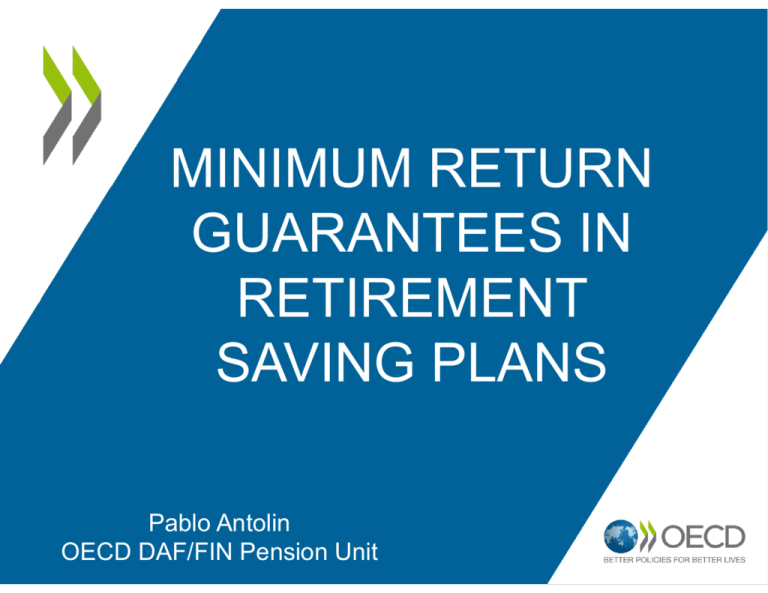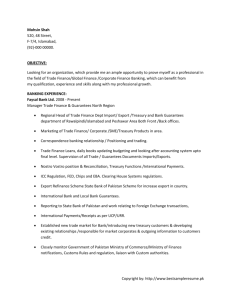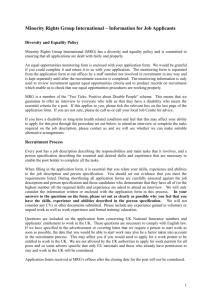Minimum return guarantees in Retirement saving plans
advertisement

MINIMUM RETURN GUARANTEES IN RETIREMENT SAVING PLANS Pablo Antolin OECD DAF/FIN Pension Unit Outline of the presentation ¾Why guarantees? ¾Return guarantees in DC pension in context ¾Types of return guarantees ¾Focusing on MRG ¾Cost of MRG ¾Capital guarantees (MRG) ¾Policy recommendations 2 Why return guarantees? ¾The volatility in retirement income stemming from DC pension plans and the impact of the recent financial crisis has led regulators, policy makers and market participants to discuss several measures to attenuate it ¾Measures include introducing guarantees in DC pension plans, as well as defaults and LC investment 3 Volatility of retirement income in DC plans 4 Return guarantees in DC plans in context ¾When assessing the need of guarantees in DC plans one needs to look at the pension system as a whole. 5 Return guarantees in DC plans in context ¾Guarantees in DCs less necessary in countries PAYG-financed public pensions already provides a high level of benefits and ¾where there are public safety nets that compensate workers – especially low income ones - from a low investment return on their funded pension contributions. 6 Return guarantees in DC plans in context ¾Guarantees are most useful where DC pension plans provide a large part of the overall retirement income and when membership of such plans is mandatory 7 Types of return guarantees ¾Fixed or minimum return guarantees ¾Absolute guarantees (e.g. 2%) or relative (e.g. set in relation to a benchmark) ¾Guarantees that may be met on the accumulated savings at retirement or every period (e.g. year) ¾When the fees are paid (annually, end of period, if surplus) 8 Focusing on minimum return guarantees (MRG) ¾The effects of market risk on DC pensions can be alleviated by introducing MRG ¾MRG only ensure that the amount of the accumulated savings at retirement does not fall below a certain value, but the actual pension benefit received after retirement will vary above that ceiling depending on the type of pay-out product chosen and market conditions at that time of retirement. 9 Focusing on MRG ¾MRG thus protect retirement income in DC plans against major investment losses. ¾MRG could also enhance people’s appreciation of and confidence in DC pensions and in turn boost the coverage of and contributions to these plans. ¾However, as guarantees have to be paid for, they reduce the expected value of retirement income from DC plans. 10 The cost of MRG ¾The cost of MRG can be relatively high depending on risk aversion and the trade-off protection and reduce expected value of retirement income. 11 Capital guarantees (MRG) ¾Capital guarantees that protect the nominal value of contributions in DC pension plans can be relatively cheap to provide, ¾offer an attractive cost-benefit trade-off for plan members, and ¾are valued highly by plan members as 12 Capital guarantees (MRG) ¾they address one of the main concerns about DC plans among the general population: people are often disinclined to save in DC plans because they feel they can lose even part of the money they put in. 13 Capital guarantees (MRG) ¾Capital guarantees are relatively cheap and easy to implement if and only if: ¾(1) fixed and long contribution period (e.g. 40 years), ¾(2) the investment strategy does not change. ¾Relaxing any of these features would raise the cost of the capital guarantees substantially. 14 Capital guarantees (MRG) ¾Establishing MRG requires addressing additional concerns: ¾(1) guarantees in DC systems can hamper members’ mobility across providers or fund managers, ¾(2) the investment choice inherent to a DC system also makes the design of guarantees cumbersome, as the price of the guarantee varies with the riskiness of the investment portfolio. 15 Additional concerns with MRG ¾The introduction of guarantees has led providers to move to very conservative investment portfolios, reducing expected long-term returns. ¾Therefore, although guarantees can limit the impact of investment risk, their use to achieve this objective may be inherently inconsistent with DC pension plans 16 Additional concerns with MRG ¾ Inconsistency because conservative investment strategies preclude participants from profiting from the long-term investment horizon that characterizes DC pension plans, ¾ But in their absence the guarantee can be expensive and may expose plan participants, and sponsors, to the risk of underfunding associated with a defined benefit plans ¾ Finally, guarantees raise the need to ensure adequate protection from the insolvency of the guarantor 17 Conclusions ¾ MRG guarantees are costly. The provide protection against volatility at a cost ¾ Only MRG applied at the end of the accumulation period and not annually have a cost that may be affordable. ¾ Capital guarantees are quite attractive. Less costly and protect people contributions ¾ But there are many issue to consider when designing MRG that may have negative repercussions on pension benefits 18 THANK YOU VERY MUCH www.oecd.org/insurance/private-pensions 19







